Integrated Medical Systems, Inc., a medical technology systems integrator transforming critical care, announced that it has received a commitment for approximately $3.25 million in funding from the U.S. Army's Medical Research Material Command for acquisition and ongoing development of the company's MedEx 1000(TM) "suitcase" intensive care unit (ICU).
"Following last fall's FDA clearance of the MedEx 1000 product," said Todd Kneale, president and chief operating officer of Integrated Medical Systems, Inc., "this order for MedEx 1000 units is the next step towards transforming critical care, both on the battlefield and here at home. In addition, the contract will allow further enhancements of the product, demonstrating the Army Medical Department's Development and Acquisition agency commitment to continuously improving healthcare."
Initial deliveries of the FDA-cleared MedEx 1000 began last month. IMS expects to have secured CE Mark certification this month, permitting marketing and sales in Europe.
The MedEx 1000 is a portable unit intended to supply ICU functionality for adult and pediatric patients. The MedEx 1000 combines the following medical device capabilities into a single platform: Physiological monitoring (electrocardiogram, invasive pressure monitoring, non-invasive blood pressure monitoring, temperature, blood oxygen saturation, and heart rate), low rate and high rate infusion pumps, a fluid warmer, a ventilator with carbon dioxide monitoring capabilities and the ability to deliver oxygen to a patient. The functions of the MedEx 1000 are controlled from a central user interface. The MedEx 1000 may be operated using either hot-swappable battery power or an external source. The unit can accept external high pressure or low pressure sources of oxygen. A USB Port provides connectivity to an external printer, and allows for a connection of a USB flash drive to off-load (download) logged data. An Ethernet Port allows for Local Area Network (LAN) connectivity. The MedEx 1000 is intended to be used in hospitals, aircraft, ambulances, field hospitals, and extended care facilities. A future upgrade will allow additional medical devices to be added using the Auxiliary Device Port and be controlled and displayed through the MedEx 1000. 
The purpose of the MedEx 1000 is to help support continuous patient care during transport from outside of the hospital or within the hospital environment. Current practice includes frequently disconnecting and reconnecting a patient from therapy and monitoring when a patient is transported. During transport, caregivers have to juggle multiple medical devices and when they arrive at a destination, connect the devices to a central computer. Use of the MedEx 1000 not only increases patient safety, but caregiver efficiency, as well. Clinical studies with the predicate device, the LSTAT(TM) stretcher-based integrated patient care platform, demonstrated the need for fewer caregivers during transport, faster response time to adverse events, faster 'time to go' between wards, and potential reduction in the hospital length-of-stay ("Life Support for Trauma and Transport: a mobile ICU for safe in-hospital transport of critically injured patients", Velmahos et al, Journal of the American College of Surgeons, 2004 July;199 (1):62-8).